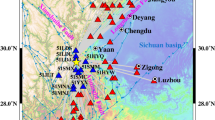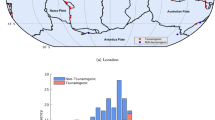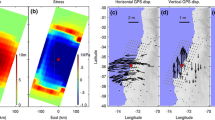Abstract
The hybrid slip model used to generate a finite fault model for near-field ground motion estimation and seismic hazard assessment was improved to express the uncertainty of the source form of a future earthquake. In this process, source parameters were treated as normal random variables, and the Fortran code of hybrid slip model was modified by adding a random number generator so that the code could generate many finite fault models with different dimensions and slip distributions for a given magnitude. Furthermore, a simple method to choose an optimal one from these generated models was proposed. The 1994 Northridge earthquake was taken as an example to demonstrate the procedure of the application of the improved model. Three rock stations, LV3, MCN and PCD, in near-field were used to compare the simulated ground motion from the improved model and optimal model with the observed one. The agreement between them in the periods of interest indicates that the improved model and the method to choose the optimal model are available for the engineering practice of ground motion estimation.
Similar content being viewed by others
References
Tao X X, Anderson J G. Near field strong ground motion simulation[C]. In: Proceedings of ICANCEER. Harbin, China, 2002.
Mikuno T, Miyatake T. Dynamical rupture process on a three-dimensional fault with non-uniform frictions and near-field seismic waves[J]. Geophys J R Astr Soc, 1978, 54(2): 417–438.
Andrews D J. A stochastic fault model(I): Static case[J]. J Geophys Res, 1980, 85(B7): 3867–3877.
Andrews D J. A stochastic fault model(II): Timedependent case[J]. J Geophys Res, 1981, 86(B11): 10821–10834.
Herrero A, Bernard P. A kinematic self-similar rupture process for earthquakes[J]. Bull Seism Soc Am, 1994, 84(4): 1216–1228.
Bernard P, Herrero A, Berge C. Modeling directivity of heterogeneous earthquake ruptures[J]. Bull Seism Soc Am, 1996, 86(4): 1149–1160.
Zeng Y H, Aderson J G, Guang Y. A composite source model for computing realistic synthetic strong ground motions reference[J]. Geophys Res Lett, 1994, 21(8): 725–728.
Olson A H, Apsel R J. Finite faults and inverse theory with applications to the 1979 Imperial Valley earthquake[J]. Bull Seism Soc Am, 1982, 72(6): 1969–2001.
Harzell S H, Heaton T H. Inversion of strong ground motion and teleseismic waveform data for the fault rupture history of the 1879 Imperial Valley, California, earthquake[J]. Bull Seism Soc Am, 1983, 73(6): 1553–1583.
Fukuyama E, Irikura K. Rupture progress of the 1983 Japan Sea (Akita-Oki) earthquake using a waveform inversion method[J]. Bull Seism Soc Am, 1986, 76(6): 1623–1640.
Takeo M. An inversion method to analyze the rupture processes of earthquakes using near-field seismograms[J]. Bull Seism Soc Am, 1987, 77(2): 490–513.
Lay T, Kanamori H. An asperity model of large earthquake sequences[C]. In: Earthquake Prediction. An International Review. Symposium on Earthquake Prediction. Washington DC, USA, 1981. 579–592.
Tsai P C C. Ground motion modeling for seismic hazard analysis in the near-source regime: An asperity model[J]. Pure Appl Geophys, 1997, 149(2): 265–297.
Somerville P G, Irikura K, Graves R W et al. Characterizing crustal earthquake slip models for the prediction of strong ground motion[J]. Seismic Res Lett, 1999, 70(1): 59–80.
Hisade Y. A theoretical Omega-square model considering the spatial variation in slip and rupture velocity. (Part 2): Case for a two-dimensional source model[J]. Bull Seism Soc Am, 2001, 91(4): 651–666.
Wang Haiyun. Finite Fault Model Source Model for Predicting Near-Field Strong Ground Motion[D]. Harbin Institute of Engineering Mechanics, China Earthquake Administration, 2004(in Chinese).
Gallovic F, Brokesove J. On strong ground motion synthesis with k −2 slip distributions[J]. J Seismo, 2004, 8(2): 211–224.
http://peer.berkeley.edu/products/nga_flatfiles_dev.html. 2006.
Wald D J, Heaton T H, Hudnut K W. The slip history of the 1994 Northridge, California, earthquake determined from strong-motion, teleseismic, GPS and leveling data[J]. Bull Seism Soc Am, 1996, 86(1): S49–S70.
Motazedian D, Atkinson G M. Stochastic finite-fault modeling based on a dynamic corner frequency[J]. Bull Seism Soc Am, 2005, 95(3): 995–1010.
Boore D M, Joyner W B. Site amplifications for generic rock sites[J]. Bull Seism Soc Am, 1997, 87(2): 327–341.
Tao Xiaxin, Sun Xiaodan. Prediction of Strong Ground Motion of Zhangzhou Basin and Its Vicinity Caused by a W M 6. 0 Strong Earthquake on the Jiulongjiang Fault[R]. Harbin Institute of Technology, Harbin, China, 2007(in Chinese).
Tao Xiaxin, Sun Xiaodan. Seismic Hazard Assessment of Active Faults in Lanzhou City[R]. Harbin Institute of Technology, Harbin, 2007(in Chinese).
Author information
Authors and Affiliations
Corresponding author
Additional information
Supported by National Natural Science Foundation of China (No. 50778058 and No. 90715038), National Key Technology Research and Development Program of China (No. 2006BAC13B02) and Major State Basic Research Development Program of China (“973” Program, No. 2008CB425802).
SUN Xiaodan, born in 1980, female, doctorate student.
Rights and permissions
About this article
Cite this article
Sun, X., Tao, X., Tang, A. et al. Hybrid slip model for near-field ground motion estimation based on uncertainty of source parameters. Trans. Tianjin Univ. 16, 61–67 (2010). https://doi.org/10.1007/s12209-010-0012-7
Accepted:
Published:
Issue Date:
DOI: https://doi.org/10.1007/s12209-010-0012-7




